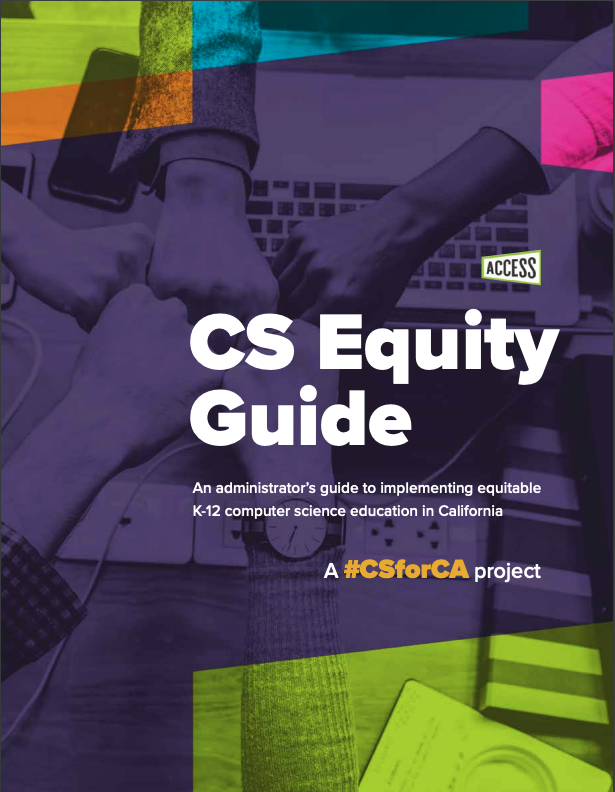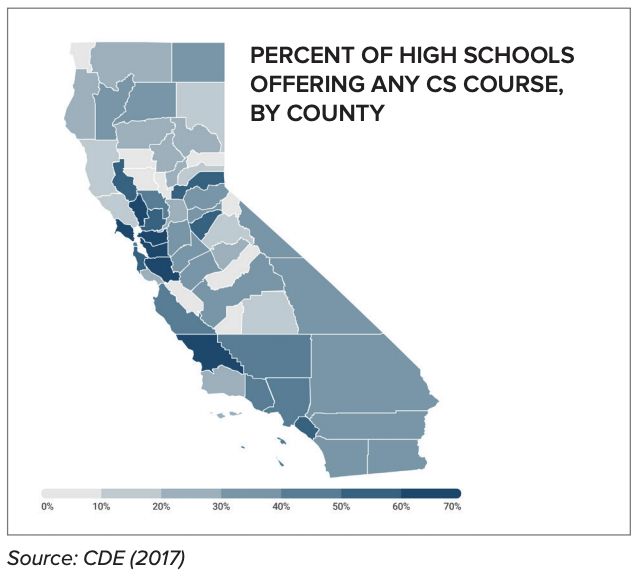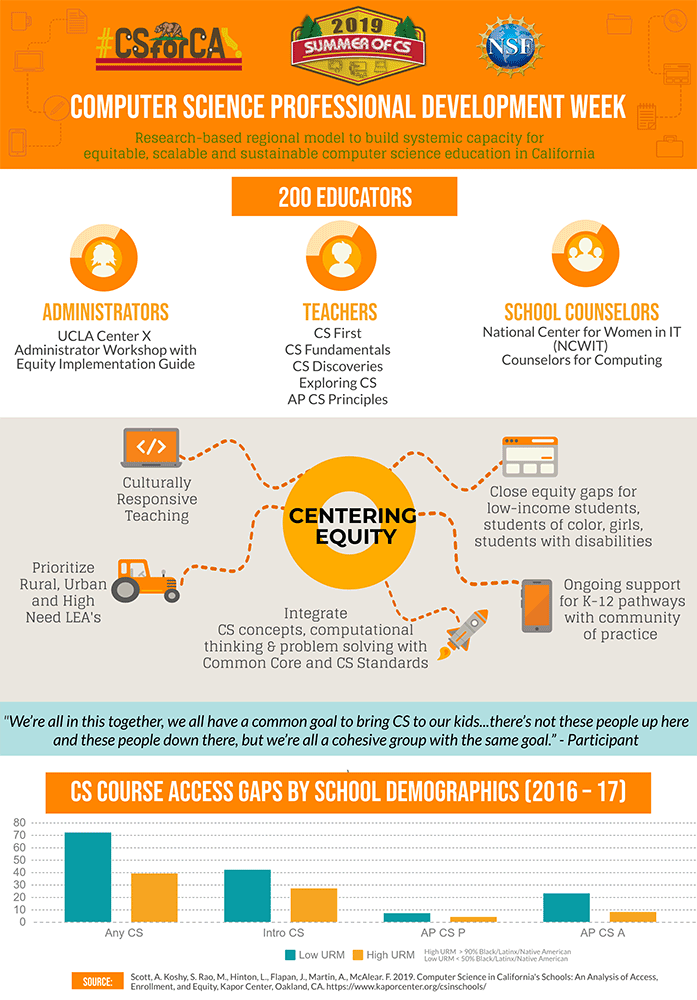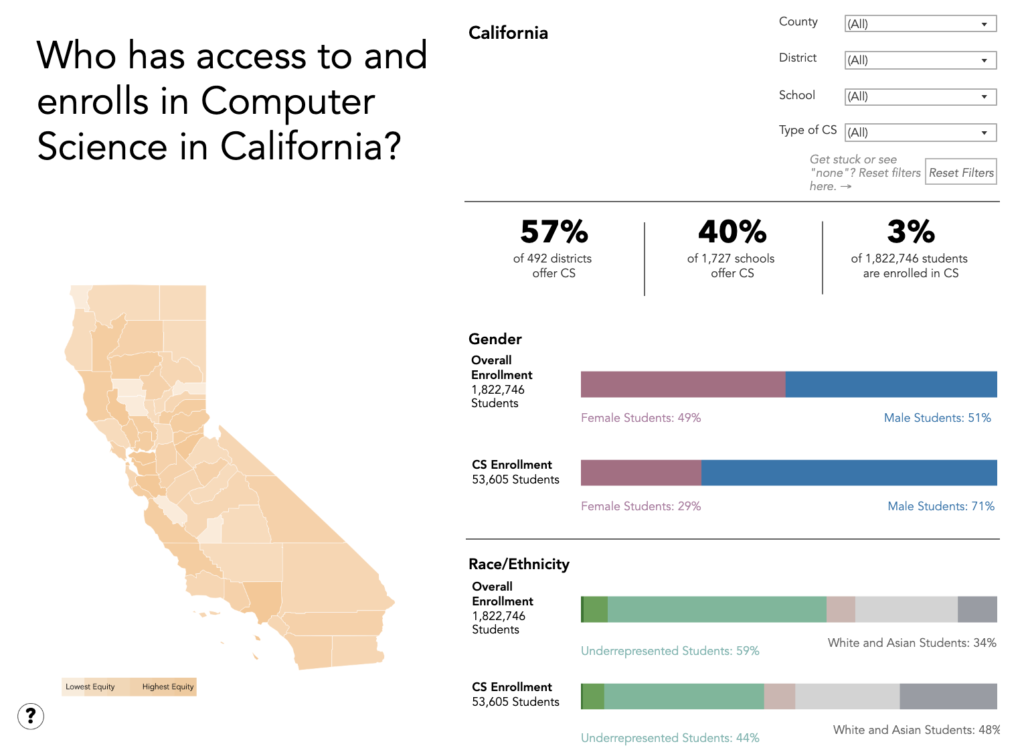We believe that computer science education is critical for all students in California, regardless of zip code, race, gender, or economic background. And thanks to the CSforCA coalition’s educators, advocates, industry leaders, nonprofit organizations, and higher education institutions, 2019 was a year of many exciting accomplishments and milestones for computer science equity in California. Here are ten of our top highlights from 2019.
10. We launched a new website!
Our new CSforCA website serves as a hub for Californians to learn more about computer science education, for educators to take action to increase computer science equity in their schools and districts, for students and parents to find out if their school offers equitable computer science education, and about statewide policy priorities to increase computer science access and equity. In addition to resources, news and updates, CSforCA website features:

9. We created the CS Equity Guide, an administrator’s toolkit for implementing equitable computer science education. To accompany the Guide, we developed and piloted an accompanying workshop for school leaders including principals, superintendents, TOSA’s, and CS Coordinators.

The CS Equity Guide was developed in response to frequently asked questions about how to implement equitable computer science education. We’ve received feedback about the Guide from administrators who say it is an important resource to transform CS education implementation in California by increasing opportunities for all students, including low-income students, students of color, young women, English learners, and students with special needs. The guide includes sections on how to create CS pathways, preparing and supporting teachers, funding opportunities, and what equitable CS looks like in the classroom.
8. We published a landscape report on computer science access, enrollment and equity across California.
Using data from the Department of Education, we analyzed 5 years of data on computer science in California. The findings were concerning: Far too few students in California have access to computer science courses, particularly low-income students, students of color, and rural students.

The report concludes with a set of specific policy recommendations to increase computer science access and equity across the state. The report’s release also garnered extensive media coverage:
7. Computer Science Can Now Count as a Science Course for UC/CSU A-G admissions requirements.
The University of California expanded its admissions requirements, allowing computer science to count for a third year of science, and no longer just an elective. This important policy change can provide an increased incentive for schools to offer computer science and for students to take computer science courses. See this FAQ, we prepared to help schools unpack what the changes mean at the local level.
6. We shared our research, strategies, and opportunities to multiple stakeholders to take action in California and across the country.
We spent a lot of time on the road in 2019, speaking to audiences of policymakers, administrators, researchers, and teachers about the importance of computer science education and how we can increase access and equity in CS education. We presented to the California School Boards Association, the California Legislative Black Caucus, the California Science Teachers Association and at conferences including the Special Interest Group on CS Education, CSEdCon, EdTrust West’s Equity Forum, the American Education Research Association, and the National Science Foundation’s CSforAll.
We also published an OpEd in The Hill on the importance of equitable CS education for all students in California--and the entire country.
5. We created infrastructure for the coalition, including 5 working groups to advance CS across our state.
As the coalition has grown, we sensed the need to provide more structure to our work. We created 5 working groups to more effectively utilize the brilliance of our coalition members to help drive our work. The 5 working groups include: Policy, Coalition-Building, Teaching and Learning (K-12), Higher Education, and Research and Communications. Our working groups helped achieve many of our goals this year.
4. We piloted the Summer of CS, a week of professional learning for CS educators, counselors, administrators, and policymakers in Sacramento.

Over 200 educators attended Summer of CS in Sacramento with workshops for administrators, school counselors and teachers with curriculum and professional development provided by code.org, exploring computer science, CS first and CS principles.
See this infographic to learn more about this model which can be adapted on a regional basis.
3. We created a searchable data tool to allow stakeholders across the state to examine whether equitable CS education is offered in your county, district, or school.
This data tool includes information on computer science course availability, and CS enrollment, by race and gender. It also includes an “equity grade” that attempts to demonstrate how well counties, districts, and schools are doing in reaching parity in CS participation by race and gender. Check it out here and use it to advocate for CS in CA!

2. Governor Newsom demonstrated his support for computer science education by including funding in his K-12 education budget.
As quoted in the Governor’s budget, “It is a priority of the administration that all students in the K-12 system are able to access computer science education to provide them with the skills they need to succeed.” The budget includes:
More excitingly, the Governor describes these budget line items as a “down payment” on a comprehensive plan to provide access to computer science for all California students.
1. California’s State Board of Education unanimously approved a strategic implementation plan for K-12 computer science education.
Two years after the state approved AB2329 (Bonilla) which called on the state to create a strategic plan for implementing computer science equitably across the state of California, the State Board of Education officially approved and adopted the final plan in May. The California Computer Science Strategic Implementation Plan was created by a 23-member panel, appointed by the Governor and State Superintendent of Public instruction. The panel, co-chaired by our own Debra Richardson, provides a roadmap for ensuring all students in California have access to computer science education. This was momentous, demonstrating the commitment of our state to computer science education, and providing a clear plan for legislators to improve access and equity for CS in CA!
Thank you for your continued support and we look forward to a successful 2020 for equity in CS in California!